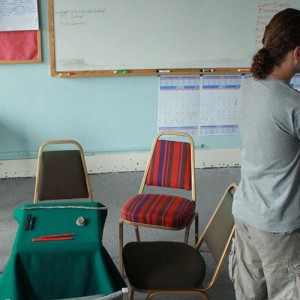48 minutes 47 seconds.
If you regularly listen to our podcasts, you know by now how highly we value debriefs, and the tremendous insight and improvement that emerges from them. In this episode, Willem debriefs Dustin’s Squamish Language Night game, for the first time in a few weeks.
1. Technique “the Lotus“
- Dustin describes his “set-up“, and his routine of arranging the chairs and table in a “lotus” pattern.
2. Technique “Inner Circle“
- He focused only on the “inner circle”, rather than including chairs in the “lunatic fringe“.
3. Technique “You asked for it…“
- By request of his players, Dustin adds a green pen to the “limited” objects.
4. Technique “Universal Speed Curriculum“
- Dustin continues to improve the orderly “bite-sized pieces” structure of his Squamish conversation, discovering a way to accelerate even more the fluency of conversation. This kind of constant tinkering is never-ending, and a vital piece of the ever-innovating WAYK game.
5. Technique “Want/Have/Give/Take”
6. Techniques “Make Me Say Yes…“, “Make Me Say No…“
7. Techniques “Newbie Sets the Pace“, “Sorry, Charlie“
- Out of concern for “sorry, charlie“-ing a totally new player who arrives in the middle of the game, Dustin internally calls “how fascinating!” and switches gears.
8. Techniques “Newbie Last“, “Start at the Beginning“, “Set-up“, “Travels with Charlie“
- Dustin restarts the game, tuned for the new arrival, and plays just using hand signs but with Squamish grammar! This improves everybody’s game tremendously.
9. Technique “We’ll All Get There Together“
- This group benefit, stemming from the arrival of a newbie, who in other learning cultures may have been seen to “slow the game down”, illuminates a vital aspect of WAYK: everybody, no matter what their skill level or age, improves the game by participating. Everybody plays a vital role. Players of every skill level, fluency, and proficiency, are needed to make WAYK work, from total beginners to total masters of the game.
- The new player, Gloria, indeed begins to pick up Squamish quite quickly, once they add in the spoken language again, on top of the hand signs. The game is hugely successful for her.
- Gloria tells a story concerning how she knows more Halkomelem language, due to its prevalency in the formal Longhouse environment, than her own language. Halkomelem has become the common language of Longhouse ceremony in many places.
10. Technique “the Walk“
- Rained out this week, but getting more and more “obviously!” for all the players, as the weeks go by.
- Dustin plans to introduce a “watch out for cars!” element to his “Walk“.
11. Technique “What is that?“
- Playing with young children – the advantage of parenthood.
- One of the players seems less confident.
12. Technique “Pairing/One-on-One“
- Changing pace, drilling the “what is that?” play instinct outside of the WAYK group game night.
- Dustin speaks specifically about the WAYK game skills he’s improving, just by getting more experience running games.
- Dustin continues translating technique names into Squamish language – how do you make an effective technique name?
- Technique “Copy-cat” is easy to translate into Squamish, for a particular local and cultural reason.
- Technique “Travels with Peter” (rather than “Travels with Charlie” may work for Squamish folks really well after all.
13. Technique “the Walk”
- Dustin is designing a special Squamish ethnobotany “Walk” with his sister and a local ethnobotanist, in a nearby park.
- Willem suggests he invite his WAYK night players to join in, to see how one designs a “Walk“.
- Dustin is designing, and playing, a “Walk” and a “same conversation” with his Canoe Family, during their Spring Training.





